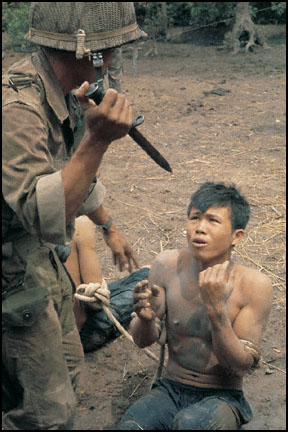 |
| Burrows, 3 days before his death in 1971 |
Larry Burrows was an English photojournalist for LIFE magazine during the Vietnam War. My aim with this research blog is to show Burrows' own intentions with his work and that his photographs affected how the American public felt about the war.
About Larry Burrows
He was born Henry Frank Leslie Burrows on May 29, 1926 in London. (Larry was a nickname to distinguish him from another man with the same name. The name was given to him by either soldiers or fellow LIFE staff.) He was inspired to pursue journalism at 14 due to the London Blitz. He said he wanted to "'show the interested people and shock the uninterested' into recognizing the horrors of war."(Pyle and Faas 22) He received two Robert Capa awards for his photo essays, including his Yankee Papa 13 essay, which is ironic considering Burrows was (falsely) accused of being the darkroom technician who ruined the majority of Capa's D-Day photographs.
Burrow's Intentions in Photojournalism
The video below captures how Burrows felt about his photographs in his own words. (8:58 is when Larry Burrows' part begins)
Vietnam - The Camera at War
Disillusionment with the Vietnam War
Burrows' photos for LIFE in the mid 60s had a major impact on the American public in showing the sacrifices of their soldiers. However, starting in 1968 he had began to become disillusioned with the war and his focus switched from the American soldier to the South Vietnamese civilian.
The photos below were taken in 1962-1966 and their perspective is of the American soldiers.
 |
| 1962 |
 |
| "Marine Helicopter Operations in Vietnam" 1965 |
 |
| "South of the DMZ" or "Reaching Out" 1966 |
As Burrows becomes disenchanted with the war, he starts to take photos that show the perspective of South Vietnamese civilians and soldiers. Because Burrows was such an influential photojournalist, the way he presented the war affected and altered the way many people felt about it. The disillusion that he felt was mirrored in the public.
"Burrows's close attention to these stories of injured children both announced and deflected his growing unease about the meaning and impact of the war. Unwilling or unable to decry US involvement in Vietnam, he picked out and underlined the human suffering of the South Vietnamese." (Kennedy)
 |
| "Nguyen Thi Tron, a young amputee who lost her leg during an accidental US helicopter attack" 1969 |
| "South Vietnamese Soldiers - A People and a War" 1969 |
